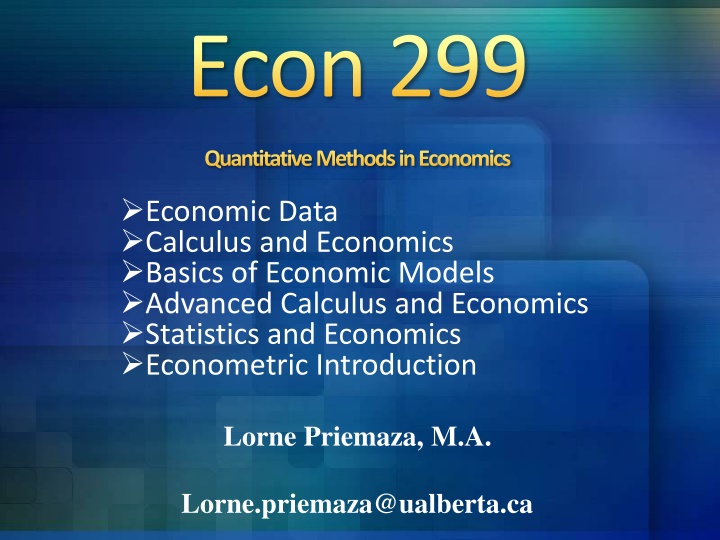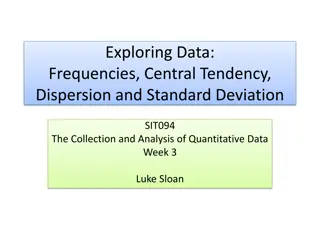
Econ 299: Quantitative Methods in Economics
Learn about the importance of data in economics, covering topics such as data types, presentations, manipulating data, real vs nominal variables, price indexes, growth rates, interest rates, and more. Explore time series data and its significance in analyzing economic trends, with examples of tuition fees, GDP, and video game ratings. Delve into how economists use data to describe economies, test theories, and make informed decisions. Dive into the fundamentals required for understanding economic models and statistics.
Uploaded on | 2 Views
Download Presentation

Please find below an Image/Link to download the presentation.
The content on the website is provided AS IS for your information and personal use only. It may not be sold, licensed, or shared on other websites without obtaining consent from the author. If you encounter any issues during the download, it is possible that the publisher has removed the file from their server.
You are allowed to download the files provided on this website for personal or commercial use, subject to the condition that they are used lawfully. All files are the property of their respective owners.
The content on the website is provided AS IS for your information and personal use only. It may not be sold, licensed, or shared on other websites without obtaining consent from the author.
E N D
Presentation Transcript
Econ 299 Quantitative Methods in Economics Economic Data Calculus and Economics Basics of Economic Models Advanced Calculus and Economics Statistics and Economics Econometric Introduction Lorne Priemaza, M.A. Lorne.priemaza@ualberta.ca
1. Data Description, Presentation, and Manipulation 1.1 Data Types and Presentations 1.2 Real and Nominal Variables 1.3 Price Indexes 1.4 Growth Rates and Inflation 1.5 Interest Rates 1.6 Aggregating Data: Stocks and Flows 1.7 Seasonal Adjustment Appendix 1.1 Exponentials and Logarithms
Why do economists need data? 1) Describe Economy Current and past data Increases and decreases This information can influence decisions ie: GDP, interest rate, unemployment, price, debt, etc. 2) Test Theory Does variable A affect variable B? ie: Smokers and the cost to healthcare ie: Married couples and health
1 Data Types Data is essential for economists. Data can be categorized by: 1) How it is collected: time series data cross-sectional data panel data 2) How it is measured: nominal data real data
Time Series Data -Collects data on one economic agent (city/person/firm/etc.) over time -Frequency can vary (yearly/monthly/ quarterly/weekly/daily/etc.) -ie: Canadian GDP, GMC stock value, your height, U of A tuition, world population
Albertas Tuition Time Series University Tuit 99/00 Tuit 00/01 Tuit 01/02 Tuit02/03 3551.00 3770.00 3890.00 4032.00 Alberta 2295.00 2295.00 2181.00 2661.00 British Columbia 3650.00 3834.00 3975.00 4120.00 Calgary 1668.00 1668.00 1668.00 1668.00 Concordia 3360.00 3470.00 3470.00 3470.00 Lethbridge 3005.00 2796.00 2807.00 2818.00 Manitoba 1668.00 1668.00 1668.00 1668.00 McGill 3760.00 3892.00 4009.00 4085.00 Ottawa
China GDP Time Series Year GDP (In current US$, in trillions) 2007 3.52 2008 4.56 2009 5.06 2010 6.04 2011 7.49 2012 8.46 2013 9.49 2014 10.4 Source: World Development Indicators, The World Bank, www.worldbank.org
Final Fantasy Quality -Time Series Data # Year Rating # Year Rating 1 1987 7.5 1 1987 9 2 1988 6.5 2 1988 5 3 1990 7.3 3 1990 7 4 1991 8.3 4 1991 10/12 5 1992 7.1 5 1992 4 6 1994 8.7 6 1994 11 7 1997 9.4 7 1997 8 8 1999 9.2 8 1999 Source: the truth 7 Source: www.thefinalfantasy.com Time Series: One Agent Many Time Periods
Cross Sectional Data -Collects data on multiple economic agents (locations/persons/firms/etc) at one time -Taken at one specific point in time (September report, January report, etc.) -ie: current stock portfolio, hockey player stats, provincial GDP comparison, last year s grades
99/00 Tuition Cross Sectional University Tuit 99/00 Tuit 00/01 Tuit 01/02 Tuit02/03 3551.00 3770.00 3890.00 4032.00 Alberta 2295.00 2295.00 2181.00 2661.00 British Columbia 3650.00 3834.00 3975.00 4120.00 Calgary 1668.00 1668.00 1668.00 1668.00 Concordia 3360.00 3470.00 3470.00 3470.00 Lethbridge 3005.00 2796.00 2807.00 2818.00 Manitoba 1668.00 1668.00 1668.00 1668.00 McGill 3760.00 3892.00 4009.00 4085.00 Ottawa
Canadian Provincial Corporate Tax 2015 -Cross Sectional Data BC Alberta Saskatchewan Manitoba Ontario Nova Scotia 11% 12% 12% 12% 11.5% 16% Source: Canada Revenue Agency (http://www.cra-arc.gc.ca/tx/bsnss/tpcs/crprtns/prv/menu-eng.html), NDP platform (Alberta) *Refers to the higher rate; not applicable to small business
Timothy A. Students Weekly Time Spent Studying for Midterms -Cross Sectional Data Course English 101 Philosophy 262 Llama Studies 371 Economics 282 Economics 299 Hours 6 12 2 11 25 Cross Sectional: Many Agents One Time Period
Panel Data -Combination of Time Series and Cross-sectional Data -Many economic agents -Many time periods -More difficult to use -Often required due to data restrictions -also referred to as pooled data
Pooled Tuition University Tuit 99/00 Tuit 00/01 Tuit 01/02 Tuit02/03 3551.00 3770.00 3890.00 4032.00 Alberta 2295.00 2295.00 2181.00 2661.00 British Columbia 3650.00 3834.00 3975.00 4120.00 Calgary 1668.00 1668.00 1668.00 1668.00 Concordia 3360.00 3470.00 3470.00 3470.00 Lethbridge 3005.00 2796.00 2807.00 2818.00 Manitoba 1668.00 1668.00 1668.00 1668.00 McGill 3760.00 3892.00 4009.00 4085.00 Ottawa
1.1 Data Types Exercise: What kind of data is: 1) Election Predictions 10 days before an election? 2) MacLean s University Rankings? 3) Yearly bank account summary? 4) University Transcript after your 4th year?
1.2 Real and Nominal Variables 1. Nominal variables Measured using current prices Provides a measure of current value Ie: a movie today costs $12.
1.2 Real and Nominal Variables 2. Real variables Measured using base year prices Provides a measure of quantity (removing the effects of price change over time) Ie: a movie today costs $4.00 in 1970 dollars
A Movie in 1970 In 1970, a movie cost $0.50 BUT $0.50 then was a lot more than $0.50 now. Nominal Comparison: Movie prices have increased by a factor of 24 ($0.50 -> $12) Real Comparison: Movie prices have increased by a factor of 8 ($0.50 -> $4)
GDP example Gross Domestic Product -Monetary value of all goods and services produced in an economy How do nominal and real GDP differ?
Nominal GDP -Current monetary value of all goods produced: quantities X prices -changes when prices change -changes when quantities change
The Problem with Nominal GDP Assume: prices quadruple (x4) production is cut in half (x 1/2) Nominal GDP (year 1) = 1 X 1 = 1 Nominal GDP (year 2) = 0.5 X 4 = 2 -although production has been devastated, GDP reflects extreme growth
Real GDP -Base year value of all goods currently produced: quantities X prices baseyear -doesn t change when prices change -changes when quantities change
The Solution of Real GDP Assume: prices quadruple (x4) production is cut in half (x 1/2) Real GDP (year 1) = 1 X 1 = 1 Real GDP (year 2) = 0.5 X 1 = 0.5 -real GDP accurately reflects the economy
Price Indexes (Indices) -Used to convert between real and nominal terms -different indexes for different variables or groups of variables Ie: GDP Deflator The price of GDP has risen 25% between 2002 and 2010 2002 = 100 (base year) 2010 = 125 (World Bank)
GDP Converting Between Real and Nominal Price Index = Nominal GDP x Real GDP 100 Nominal GDP = Real GDP x 100 Price Index
General Conversion Equations Price Index Nominal = x Real 100 Nominal Real= x 100 Price Index
Example: Tuition University Tuit 99/00 Tuit 00/01 Tuit 01/02 Tuit02/03 3551 3770 3890 4032 Alberta (Nominal) 100 103 106.1 109.273 Tuition Price Index* Real Tuition (1999 dollars) =(Nominal Tuition/Price Index)100 3551 3660 3667 3689.85 2295 2295 2181 2661 British Columbia (Nominal) 100 103 106.1 109.273 Tuition Price Index* Real Tuition (1999 dollars) =(Nominal Tuition/Price Index)100 2295 2228 2056 2435.19 *Based on 3% yearly inflation typical to years listed
1.3 Math Review Summation Notation X variable you are adding s starting observation n last observation n = i Xi s 6 = In this class, often simplified to: = + + + X i X X X X 3 4 5 6 3 i = observatio ALL up add ns of X X = observatio ALL up add ns of at time X t X t
1.3 Math Review Summation Notation P P + = t t Q + + ... P P Q Q Q 1 1 1 1 2 2 1 1 t t t t nt nt Add up each good s (1, 2 n) product of its price today times its quantity last term. For example, if you were in charge of food for a convention: = + BreakfastT P + P P Q BreakfastY Q LunchYeste Q 1 LunchToday t t oday esterday rday DinnerToda P DinnerYest Q y erday
1.3 Price Indexes Price indexes summarize how the cost of baskets (collections of goods or services) changes over time. The total cost of a basket is: = BasketCost PQ
1.3.2 Laspeyres Price Index -In a single basket, some prices may go up, and others may go down -Quantities purchased can also change from year to year -A Laspeyres Price Index calculates the cost of a basket in a base year, then asks how much that EXACT BASKET (base year quantities) would cost in another year -This approximates how overall prices have changed
1.3.2 Laspeyres Price Index -uses base year quantities as weights -still = 100 in base year (automatically normalized LPIt = pricest X quantitiesbase year ---------------------------------- X 100 pricesbase year X quantitiesbase year -tracks cost of buying a fixed (base year) basket of goods (ie: CPI)
Example: Movies and Karaoke Year Movies Karaoke Price Quantity Price Quantity 1 10 20 20 10 2 11 15 25 15 3 12 25 15 20 4 15 5 15 20 5 11 10 20 15
Example: Laspeyres (Base year 1) Laspeyres Price Index Cost in year t Cost in Base Year Year of base year basket of base year basket Laspeyres Price Index 1 (10*20)+(20*10) 400 (10*20) + (20*10) 400 400/400 X 100 100 2 (11*20)+(25*10) 470 (10*20) + (20*10) 400 470/400 X100 118 3 (12*20)+(15*10) 390 (10*20) + (20*10) 400 390/400 X 100 97.5 4 (15*20)+(15*10) 450 (10*20) + (20*10) 400 450/400 X 100 113 5 (11*20)+(20*10) 420 (10*20) + (20*10) 400 420/400 X 100 105
2 Price Index Calculation Methods 1) Using individual prices and quantities -Same as before 2) Using basket costs PaQb Price of basket b in year a P2012Q1997 Price in 2012 of what was bought in 1997
Method 1 Individual Prices and Quantities Laspeyres Price Index Cost in year t Cost in Base Year Year of base year basket of base year basket Laspeyres Price Index 1 (10*20)+(20*10) (10*20) + (20*10) 400/400 X 100 100 2 (11*20)+(25*10) (10*20) + (20*10) 470/400 X100 118 3 (12*20)+(15*10) (10*20) + (20*10) 390/400 X 100 97.5 4 (15*20)+(15*10) (10*20) + (20*10) 450/400 X 100 113 5 (11*20)+(20*10) (10*20) + (20*10) 420/400 X 100 105
Method 2 Basket Costs Laspeyres Price Index Cost in year t Cost in Base Year Year of base year basket of base year basket Laspeyres Price Index 1 400 400 400/400 X 100 100 2 470 400 470/400 X100 118 3 390 400 390/400 X 100 97.5 4 450 400 450/400 X 100 113 5 420 400 420/400 X 100 105
Method 2 Example Every year, Lillian Pigeau likes to travel. The first year, she went to Maraket, the second year to Ohm, and the third year to Moose Jaw. The costs of those trips are as follows: Moose Jaw Year Ohm Maraket 1 $1,000 $650 $800 2 $1,100 $550 $900 3 $1,200 $700 $600
Method 2 Laspeyres (Year 1 Base Year) P P Q t b = 100 ( ) LPI t Q b b Moose Jaw Year Ohm Maraket P Q 1 1 = 100 ( ) LPI 1 $1,000 $650 $800 1 P Q 1 1 2 $1,100 $550 $900 $ 800 3 $1,200 $700 $600 = 100 ( ) LPI 1 $ 800 = 100 LPI 1
Method 2 Laspeyres (Year 1 Base Year) P P Q t b = 100 ( ) LPI t Q b b Moose Jaw Year Ohm Maraket P Q 2 1 = 100 ( ) LPI 1 $1,000 $650 $800 2 P Q 1 1 2 $1,100 $550 $900 900 $ 3 $1,200 $700 $600 = 100 ( ) LPI 2 800 $ = 112 5 . LPI 2
Method 2 Laspeyres (Year 1 Base Year) P P Q t b = 100 ( ) LPI t Q b b Moose Jaw Year Ohm Maraket P Q 3 1 = 100 ( ) LPI 1 $1,000 $650 $800 3 P Q 1 1 2 $1,100 $550 $900 $ 600 3 $1,200 $700 $600 = 100 ( ) LPI 3 $ 800 = 75 LPI 3
1.3.3 Splicing Price Indexes -As time goes on, base years change -Prices and quantities of horses and cars in the 1960 s are a little different than today -This creates price indexes with different base years, spanning different periods -Sometimes these differing price indexes need be spliced together
1.3.3 Splicing Price Indexes 1) Find a year with price indexes from BOTH series & calculate a conversion factor Conversion factor = Price Index (new base) -------------------------------------------------- Price Index (old base) New = index you want to fill in Old = index you want to convert 2) Multiply old index by conversion factor to fill in new index
Ie: Price Index (Computers) Year Price Index Price Index Calculations (1989=100) (1992=100) 120 100 95 92 Price Index (1992=100) 1988 1989 1990 1991 1992 1993 1994 120 X (110/92) 100 X (110/92) 95 X (110/92) 143 120 114 110 100 95 95 Exercise: How would the full price index look with 1989 as the base year?
Getting Data Ready Sometimes data needs to be formatted before it can be analyzed statistically: 1) Growth in variables must be calculated 2) An effective yearly interest rate is needed 3) Real interest rates must be calculated 4) Stock or Flow variables must be aggregated (for example, changed from daily to monthly data) 5) Seasonal effects must be accounted for The rest of the chapter will cover these tools
1.4 Growth Rates and Inflation Growth Rates are important concepts in economics. Inflation = growth rate of CPI (all items) Growth = { (Xt Xt-1)/ Xt-1 } X 100 = { ln(Xt) ln(Xt-1) } X 100 Note: g = (Xt Xt-1)/ Xt-1
1.4 Growth Rates Example UBC tuition in 2001/2002: $2181. In 2002/2003 it was $2661 Growth = { (2661-2181)/2181 } X 100 = 22.01% Growth = { ln(2661) ln(2181) } X 100 = 19.89% U of A tuition in 2001/2002: $3890. In 2002/2003 it was $4032 Growth = { (4032-3890)/3890 } X 100 = 3.65% Growth = { ln(4032) ln(3890) } X 100 = 3.59%
1.4 Log Growth Restrictions Growth = {ln(Xt) ln(Xt-1)} X 100 The log growth formula is only appropriate when growth is small. If the log growth formula reveals large growth, use the normal growth formula instead
Why two growth formulas? (proof) If g is SMALL g ln (1+g) ln(1+g) = ln [1+(Xt-Xt-1)/Xt-1] = ln [(Xt-1+Xt-Xt-1)/Xt-1] = ln [Xt/Xt-1] = ln [Xt] ln[Xt-1] Therefore g ln [Xt] ln[Xt-1] or (Xt-Xt-1)/Xt-1 {ln [Xt] ln[Xt-1]}
Log Review 1) Division Rule ln(A/B) = ln(A) ln(B) 2) Multiplication Rule ln(AB) = ln(A) + ln (B) 3) Power Rule ln(Ab) = b X ln (A) Note: ln (A+B) ln (A) + ln (B)


















